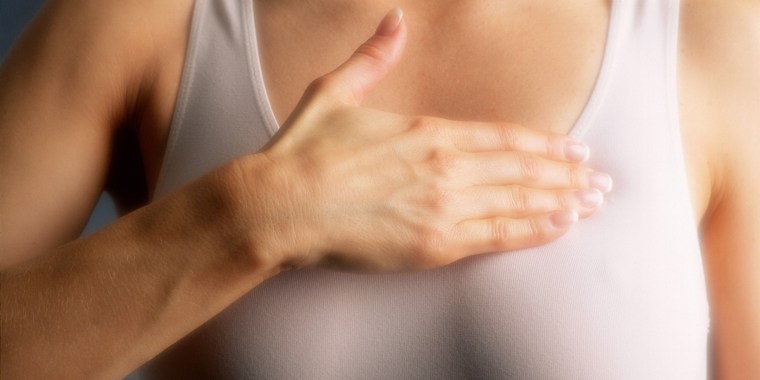When it comes to breast cancer, most women know to search for lumps — but there are some more unusual symptoms they should know about, too.
While lumps remain the most common breast cancer symptom, they aren't the only one. In fact, one study showed that 1 in 6 women diagnosed with breast cancer went to the doctor about a symptom other than a lump.
Here are some of the less common breast cancer symptoms, and how to spot them.
Dents and dimples
in 2019, NBC News correspondent Kristen Dahlgren opened up about how she noticed a slight dent in her right breast on her 47th birthday. There was no lump, but she felt what she described as a thickening in her breast in this essay for TODAY Health. It turned out to be stage 2 breast cancer.
Dents like the one Dahlgren found as well as dimpling are among the lesser known breast cancer symptoms.
"When we're talking about skin dimpling, it's very specific — we call it peau d'orange because a large portion of the skin on the breast actually looks like an orange peel," said Dr. Aashini Master, an oncologist with UCLA Health in Beverly Hills, California.
Dents and dimpling may be minor, but they can have serious consequences.
"Dents or dimples in the breast are often caused by the tumor actually pulling at the skin itself," Dr. Audree Tadros, of Memorial Sloan Kettering Cancer Center in New York City, explained. "So there becomes a connection between the tumor and the skin itself, and the force pulls the skin inward, and it looks like an indentation in the breast."
Red, flaky rash
A red, flaky rash on the skin of the breast, areola or nipple is a symptom of Paget disease of the breast, a very rare form of breast cancer.
Of course, rashes can happen for a variety of other reasons, too. But if women are experiencing a rash that doesn't go away after a couple of weeks, they should see a doctor, Master said.
Redness and swelling
Red, swollen, tender breasts may be a sign of inflammatory breast cancer, another rare form of breast cancer.
Tadros, who treats patients with inflammatory breast cancer, said it is often misdiagnosed because the symptoms are also symptoms of other conditions, including many that women may experience after childbirth, including clogged milk ducts and mastitis.
"The breast goes through a lot of changes when trying to breastfeed," Tadros said.
How to know the difference? Changes to the breast that are associated with pregnancy and breastfeeding typically appear suddenly, and they should go away with some intervention.
"With something like mastitis or a clogged milk duct, what you’re going to feel is this comes on pretty quickly and breast cancer typically doesn’t," Master said. "Also, mastitis is painful. Breast cancer, for most women, isn’t painful."
Nipple discharge
Nipple discharge (other than breast milk) is another lesser known symptom of breast cancer.
That can be confusing for new moms who are experiencing discharge related to breastfeeding. But Tadros said it's really clear discharge or reddish, bloody discharge that is concerning. If that's what you're seeing, you should see a doctor.
Inverted nipple
Most women's nipples stick out. But nipple retraction is when a woman's nipple starts to turn inward, and it's a possible symptom of breast cancer.
Of course, some women have naturally inverted nipples — and that's perfectly OK.
"But if you do not, and your nipple becomes inverted, that's a concerning sign," Master said.
While it's important to know all the symptoms, it's also important for women to understand that these ones are rare, or associated with rare forms of breast cancer. The most common symptom of breast cancer is still a new lump or mass in the breast, according to the American Cancer Society.
And while knowing your body and being able to identify any sudden changes in your breast is helpful, self-exams shouldn't replace regular screenings. The American Cancer Society recommends most women start considering yearly mammograms at age 40.
Younger women should be vigilant, too. Master works with the Keep a Breast Foundation, which aims to educate young women about breast cancer, and recently launched an app to help with self-checks.
"Breast cancer does not just affect post-menopausal women," Master said. "I have many young patients who have been told that because they're so young, (their symptoms are) nothing. But if someone feels something is concerning, they need to advocate for themselves, because the earlier we catch breast cancer, the much higher likelihood that we can cure it."


